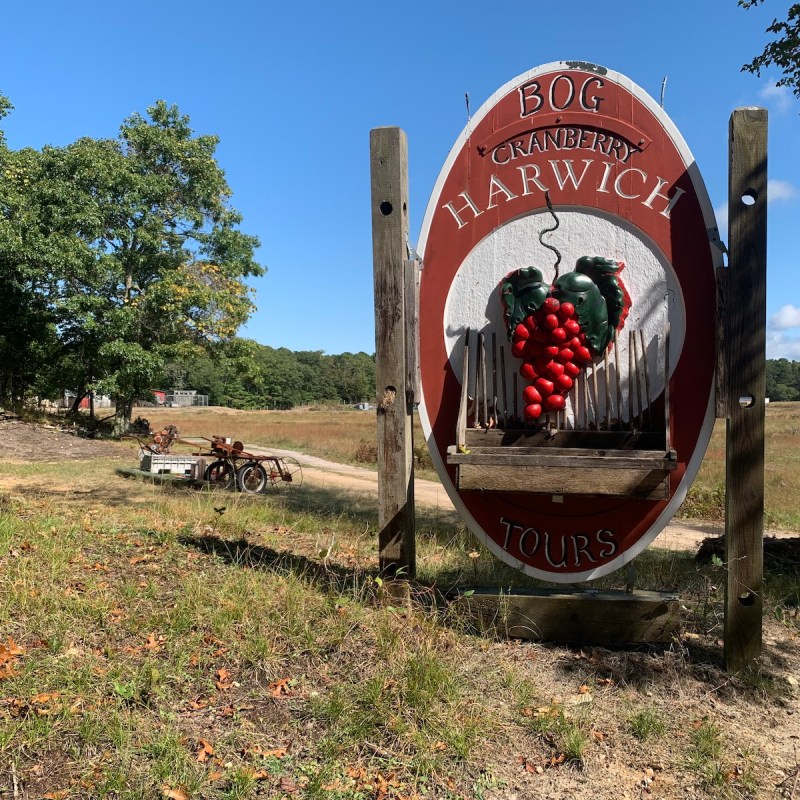
Bright red jewels bobbing across flooded bogs waiting to be corralled by waders-clad farmers on a sunny autumn day is the quintessential picture of a cranberry harvest. A cranberry farm tour is the best way to experience the harvesting of this tart and tasty ground fruit.
Videos by TravelAwaits
Attached to low-growing vines, these pretty red berries begin their journey as bright white fruit then ripen to a rich crimson just before the harvest season begins. Wisconsin and Massachusetts grow the largest amounts of cranberries consumed in the United States. New Jersey, Oregon, and Washington round out a small fraction of the remaining cranberry-growing regions.
Some information in this piece was obtained during a sponsored press trip, but all recommendations are my own.

1. The History Of Cranberry Bogs
Cranberry bogs are kettle-size holes dug by glaciers over 10,000 years ago. These holes were lined naturally with clay-type soil giving them a protective barrier. The kettle holes filled in with water, peat, and sand creating the perfect environment for the cranberry vine.
To ensure a bountiful crop of cranberries, you need sandy soil, a large freshwater supply, and enough chill hours (an extended winter dormancy period between 32 and 45 degrees Fahrenheit) to successfully grow a bumper crop.

2. A Cranberry Harvest
You can experience a cranberry harvest in two ways. Either you can watch a dry pick or a wet pick harvest. Over the course of a few days, the cranberries will be picked, sorted, and packed.
Many small family farms still use sorting equipment that has been working for generations. After the cranberries have been harvested, the bins of fruit are dumped into a hopper. As they are bounced around the sorter, the best and freshest berries are bounced down steps into an awaiting bin. These are the berries that are sold for eating and cooking.
If the berry is past its prime, it will not bounce and falls to a waiting bin below the hopper. These berries will most likely be fed to the barnyard crowd.

3. Dry Cranberry Harvesting
A dry harvest requires more work for the grower. The farmer uses a mechanical picker or an old-fashioned wooden picker to “comb” the berries off the vine.
Dry harvesting is best performed when the weather has been very dry. After the morning dew is off the fruit and plants, the dry harvest can begin. This is a more time-consuming method. Many farms do not dry pick, and only wet pick their fruit.
The cranberries you see in the market are primarily harvested using the dry method.

4. Wet Cranberry Harvesting
The classic wet cranberry harvest is possible because the cranberry has a pocket of air, so when the bogs are flooded, the berry, once shaken from the vine, can float to the water’s surface. During the wet harvest, the tart little gems will be flooded, shaken, corralled, sorted, and packed.
The night before the harvest, the bogs are flooded with up to 18 inches of water. The next day, “egg beaters” or water reels are used to stir up the water and shake the berries off the vines. The berries magically float to the surface. The floating occurs naturally because the cranberries contain tiny pockets of air.
5. Wisconsin Cranberry
According to Wisconsin Cranberries, there are 21,000 cranberry-growing acres across the state, making Wisconsin the leader in cranberry production in the U.S.
Traverse Wisconsin’s Cranberry Highway for a self-guided exploration of the state’s cranberry farms along the almost 50 miles of cranberry marshes. During the wet harvest, the fields are flooded and the beautiful berries are shaken from the vine, dancing across the water and creating a colorful, almost photogenic harvest.
The Wisconsin Cranberry Discovery Center offers a glimpse into the history of cranberry farming, harvesting, and even offers some tasty sweet and tart cranberry treats.
6. Cape Cod Cranberry
Cranberry Bog Tours in Harwich offers year-round tours that take you through the annual life cycle of a cranberry on the farm. As you ride through the fields and bogs, you encounter wandering goats and other assorted barnyard animals doing their thing.
Organic is always best, and Leo and Andrea Cakounes of Cranberry Bog Tours farm the largest organic cranberry farm on Cape Cod. With over 20 acres of certified organic berries and two harvests each year — a dry pick harvest followed by a wet pick harvest — the farm is exceptionally busy in the fall months.
If you are interested in experiencing a working cranberry farm’s day-to-day operation, this is the perfect spot.

7. Working The Cranberry Bog
There is something going on at the farm year-round. The cycle of farming and caring for the land and crops is an ongoing process. With years of proper care, you will find some Cape Cod cranberry fields have vines over 150 years old.
In January and February, the farmers flood their bogs for winter protection. Every third year or so, ice sanding is necessary to keep the bog’s sand ratio at its optimum. Sand is spread over the ice to settle into the bog as the ice melts in the spring. When there is not enough ice to safely apply to the sand, it is added to the bog in April, which is less than ideal and a much more cumbersome process.
During the summer months, tending to the fields and farms keeps everyone busy.
When September rolls around, the cranberries are ready to harvest. The growers will spend the next few months gathering their crop and distributing it to their local outlets.
Any time of year is a great time to visit and tour the farm.

8. Animal Life Supports Farmers
Every farm needs a great herding dog or two keeping a keen eye out for unwanted predators and helping wrangle the other barnyard critters. Sheep and goats are perfect sustainability partners because they graze on invasive weeds (including poison ivy). By keeping goats and sheep on the farm, the farmers can use fewer herbicides, thereby making a safer and better tasting cranberry.
Bees are another farming friend. Pollinating with abandon, bees bring fruits to vines. The wonderful side benefit is that they produce copious amounts of sweet local honey that can be harvested in the late fall.
Farming comes with its share of wildlife, too. Many are beneficial and work with the farmer, particularly the organic farmers, to keep unwanted pests under control. At the Cakounes’s farm in Massachusetts, creatures create homes for bluebirds, barn swallows, and chickadees who feed on bugs that are destructive to farmers’ crops. Bats are also welcome guests for their assistance in balancing the bug population. With the help of beneficial bugs, the farmers can reduce the amount of pesticides used on crops, making them a healthier choice to eat.
9. Organic Vs Non-Organic
We all know that organic is best, it is no different with cranberries. By reducing the amount of chemical spraying, the fruit on your Thanksgiving table or filling your juice glass is healthier.
Organically grown fruit does have a shorter shelf life, and fresh organic cranberries keep for about 40 days. However, they freeze exceptionally well, so you can store them until you are ready to turn them into your favorite quick bread or relish recipe.
Non-organic fruit has a longer shelf life, making it easier to transport long distances.

Harvesting Cranberries
Down-on-the-farm cranberry harvest tours are one of the best ways to visit and learn about cranberry farming. Get out and explore where your food is grown. Support your local family farms by touring, enrolling in a Community Supported Agriculture (CSA) program, and shopping at your local farmers markets. You will love the taste and freshness of the produce, helping support your local farmers.
Sometimes you don’t have to travel too far to experience something new. Visit a cranberry farm for an adventure into exploring the most colorful harvest of the year.
Some places celebrate harvest time with special festivals:
